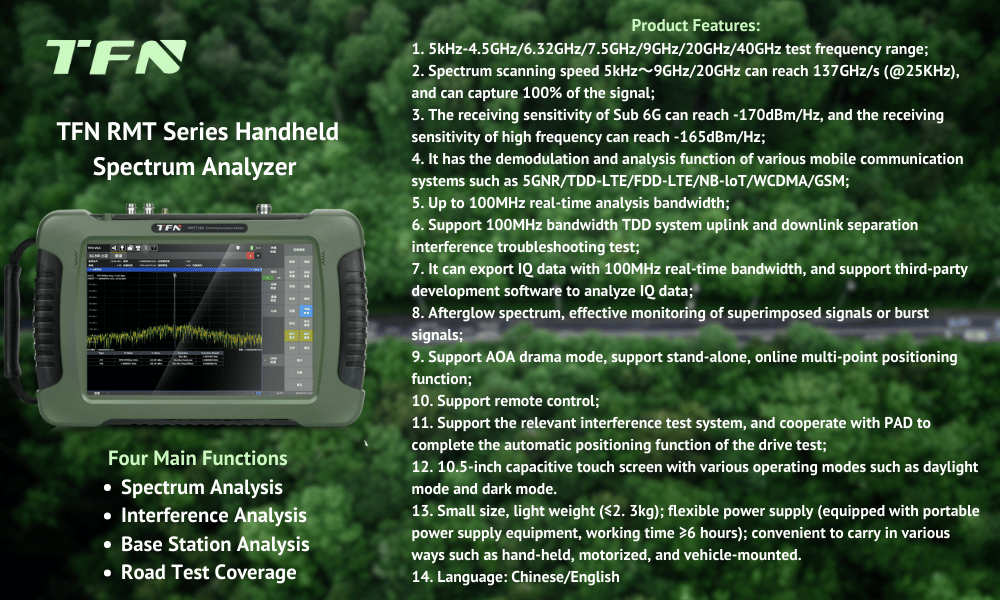What is zero span in spectrum analysis? What is its purpose?
In fields such as wireless communications, radar, and electronic countermeasures, spectrum analyzers are indispensable "eyes" for engineers, observing the frequency distribution and strength of signals. Zero span, a unique and critical operating mode of this powerful instrument, has revolutionized the way we observe signals. This article will delve into the essence and importance of zero span, drawing on practical applications of the TFN brand RMT handheld spectrum analyzer.
1. Zero span: Freezing the frequency axis, focusing on time variations
As the name suggests, zero span means that the spectrum analyzer sets the frequency span to zero. This may sound contradictory—if the frequency span is zero, what can be "analyzed"?
The core principle is that when the span is set to zero, the spectrum analyzer's center frequency is fixed at a specific frequency point. At this point, the instrument no longer sweeps across the frequency axis, but instead focuses all its receiving and processing capabilities on monitoring the signal amplitude changes over time at that fixed frequency point. The instrument screen's horizontal axis (X-axis) will switch from the usual "Frequency (Hz)" to "Time (s)", while the vertical axis (Y-axis) will remain the signal amplitude (e.g., dBm).
On the TFN RMT handheld spectrum analyzer, entering zero span mode is very simple:
1.1. Press [Mode] to select "Spectrum Mode".
1.2. Press [Span] -> [Manual Span].
1.3. Set the span value to "0 Hz".
1.4. Set the center frequency and reference level.
1.5. Press [Sweep] -> [Sweep Time] to set an appropriate sweep time based on the measured signal characteristics (e.g., pulse width, period). The RMT typically supports a range of 10ms to 90s.
1.6. Observe the screen; the amplitude-time graph at a fixed frequency point is now displayed.
2. The Core Function of Zero Span: Time Domain Signal Observation and Analysis
Zero span mode transforms the spectrum analyzer into a powerful time domain observation tool. Its core value is reflected in the following aspects:
2.1. Observing Transient and Burst Signals:
In standard spectrum sweep mode, extremely short transient or burst signals (such as radar pulses, push-to-talk signals, and certain digital communication burst packets) may flash by, making them difficult to stably capture and analyze.
In zero span mode, the instrument "locks" on the target frequency. Any signal appearing at that frequency, no matter how brief, as long as it occurs within the set sweep time window, will have its amplitude variation over time (such as rising and falling edges, pulse width, and envelope shape) clearly displayed on the screen. This is crucial for debugging and diagnosing pulse signals or burst communication systems.
2.2. Measuring Pulse Parameters:
Modern spectrum analyzers, such as TFN RMT, typically feature powerful marker functions in zero span mode.
Engineers can conveniently use markers to measure key pulse parameters such as rise time, fall time, pulse width, period, duty cycle, peak power, and average power. This is crucial for applications such as radar system testing, switching power supply noise analysis, and digital modulation signal quality assessment.
2.3. Analyzing Signal Amplitude Modulation (AM):
If a carrier signal is amplitude modulated (such as an AM broadcast signal), in zero span mode, set the center frequency to that carrier frequency.
The waveform displayed on the screen, showing the amplitude variation over time, intuitively reflects the envelope shape of the modulated signal. Engineers can directly observe the modulation depth, modulation waveform distortion, and other conditions.
2.4. Detecting Intermittent Interference:
When intermittent interference is suspected at a fixed frequency (such as periodic equipment noise or irregular signal leakage), conventional sweep mode may not be able to capture it at the moment of its occurrence.
Use zero span mode to "wait for the interference" and monitor that frequency over a long period of time. Once interference occurs, its amplitude variation over time will be recorded, helping engineers determine the source, characteristics, and patterns of the interference.
3. TFN RMT Handheld Spectrum Analyzer: An Ideal Partner for Zero-Span Applications

The TFN RMT handheld spectrum analyzer, with its portability and powerful feature set, provides an excellent platform for zero-span applications:
Portable Field Testing: Its handheld design allows engineers to easily use zero-span to analyze transient signals or pulse characteristics in field scenarios such as base station commissioning, on-site interference troubleshooting, and wireless device installation and maintenance, without the need to carry a bulky oscilloscope.
High Dynamic Range and Sensitivity: The RMT series offers excellent dynamic range and displayed average noise level (e.g., ≤ -140dBm/Hz @100kHz-30MHz), providing clear and reliable traces even when observing small signals or deeply modulated signals in zero-span mode.
Flexible Trigger Settings: Combined with the trigger menu (such as free trigger and external trigger), specific transient events can be more accurately captured and stably displayed.
Intuitive Marker Functionality: Powerful marker functions (such as peak marker and time difference measurement) make precise measurements of time and amplitude parameters on zero-span traces simple and efficient. Large Display: The clear screen clearly displays the details of signal amplitude variations over time.
Summary
Zero span is not truly "zero span." It is a unique operating mode that switches the spectrum analyzer from frequency-domain observation to time-domain observation at specific frequency points. It transcends the limitations of traditional spectrum analysis, which only allows for viewing "frequency distribution," and enables engineers to observe dynamic changes in signal amplitude over time. This is crucial for analyzing pulses, bursts, transient signals, AM signal envelopes, and capturing intermittent interference.
The TFN RMT handheld spectrum analyzer integrates this powerful functionality into a portable package. Combined with its excellent RF performance, flexible triggering, and precise marker measurements, it is an ideal tool for communications engineers, RF technicians, and field maintenance personnel performing zero span observations and debugging in a variety of scenarios requiring time-domain signal analysis. Mastering and effectively utilizing the zero span function will greatly enhance your spectrum analysis work and provide deeper insights into signal secrets.
